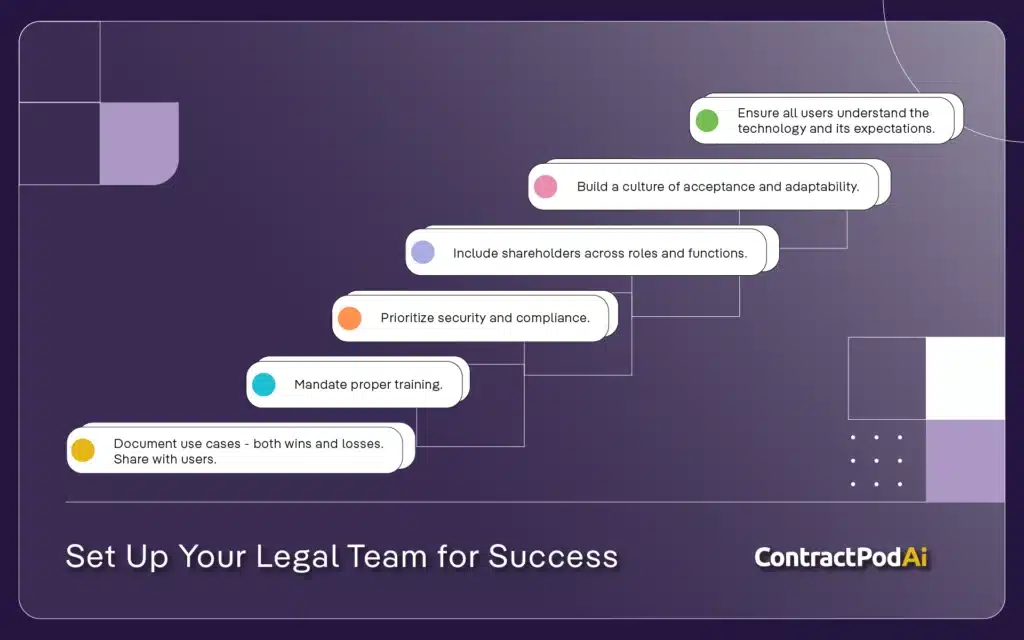Generative Artificial Intelligence (GenAI) is branch of artificial intelligence (including deep learning and machine learning) that uses massive amounts of collected data to create (or generate) human-consumable output based on the input that a user provides. To create the datasets underlying generative AI tools, massive amounts of human-created information were collected and processed into mathematical predictive models. Generative AI is adept at processing vast amounts of information to recognize, summarize, translate, compare and predict. Users leverage GenAI to generate original text, images, audio, video and code.
GenAI tools are changing the way legal services are provided because their capabilities have potential impact on so many different business areas:
- Content discovery, creation, authenticity, and regulations
- Automation
- Both the customer and employee experience
Several legal practices already rely on generative artificial intelligence to draft work significantly faster and smarter, including contracts, trial briefs, legal research, pleadings, discovery requests, deposition questions and legal marketing materials.
Law.com conducted a survey of 100 law firms to learn how they are using generative AI, and 41 firms confirmed that they have begun employing generative AI, although Law.com noted that the actual number is likely much higher. Although many of these firms and other companies have set policies, there is also the use of individual subscriptions or public services – so-called “shadow AI” usage.
Often, the terms AI and GenAI are used interchangeably. However, they offer different functionality. Traditional AI models perform specific tasks or solve specific problems by adhering to pre-defined rules and algorithms. GenAI models are not limited to specific tasks. They are trained on incredible amounts of data and can create brand-new content from that training. This makes the potential of generative AI very compelling to the legal field to expedite and enhance its role in content creation.
GenAI Offers the Following Key Benefits to In-House Legal Teams
Efficiency
Staying competitive in today’s legal world means finding ways to create more efficiencies that will continue to grow the business. GenAI can be used to accelerate time-consuming legal research tasks, such as locating relevant laws and rulings, searching through case law databases and reviewing evidence. Once it finds the information, it can then translate it into a requested format (legal documents, contracts and letters).
AI can also make document management and contract review more efficient. AI can quickly spot errors and inconsistencies, as well as draft preferred contract language. For example, a global venture capital firm embarked on a first-of-its-kind GenAI legal contract management project with the support of ContractPodAi and PwC. Leah Legal, ContractPodAi’s GenAI solution, proved it could extract complex logic-oriented data points and perform sophisticated analysis across nearly 16,500 contract pages with over 98% accuracy.
Risk Assessment and Compliance
For example, the legal team at the south-east Asian ecommerce business used generative AI to accelerate its contract review process and to identify common risks across different agreements. The team estimates that contract review is already 20% – 30% faster than its standard work.
GenAI is able to digest constantly changing regulatory laws and requirements and then highlight any discrepancies that do not align with the company. And as the models continue to learn, they can pinpoint compliance gaps, which helps leaders shift to meet the new or changing obligations.
GenAI can also enhance risk assessment in a variety of ways:
Data Augmentation:
Create realistic synthetic data that identifies the same as real-world data. This becomes especially helpful in legal situations when data is sensitive because legal departments can conduct comprehensive analyses without concern of compromising confidentiality.
Scenario Simulation and Analysis:
Generate data that “could occur” under various scenarios. This enables lawyers to assess the impact of different risk factors and eliminate negative vulnerabilities before they actually occur.
Predictive Modeling:
Predict future outcomes based on learned patterns and training. This can be extremely valuable to legal professionals who want to identify potential risks and also determine the likelihood of court decisions.
Decision-making:
Offer suggestions based on simulated outcomes and predictive analytics.
Preparing for AI Integration
A recent study conducted by ContractPodAi found that as of January 2024, more than half of in-house legal professionals (51%) say their company’s leadership encourages legal departments to use GenAI tools, and more than a third (35%) require it. GenAI is a sophisticated technology that should include both careful consideration, planning and evaluating to provide positive results to your business. So, what are the best practices for successfully integrating GenAI into your organization?
Best Practices for Integrating AI
Assess Legal Needs
When integrating AI into business operations, it is crucial to assess the legal needs meticulously to ensure compliance with relevant laws and regulations. This includes understanding data privacy laws, intellectual property rights, and industry-specific regulations, as well as the recent glut of new laws and regulations governing the use of AI for various purposes.
Companies should conduct a thorough legal audit to identify potential risks and consult legal experts to navigate the complexities of AI implementation. Establishing clear policies for data usage, obtaining necessary licenses, and ensuring transparent AI practices are essential steps in mitigating legal risks and fostering trust among stakeholders.
Identify High-Impact Areas for AI Applications
AI has potential to support several different legal practice areas. Start by identifying your operational goals and where GenAI can play the most important role to meet these goals. Areas to consider include drafting communications (memos, emails, etc.), legal research, legal narrative summaries, legal document review, legal contract creation, due diligence, discovery review and contract redlines.
Evaluate Current Workflows and Technology Infrastructure
How will GenAI fit into your current workflows? Do you have existing technology to support the implementation? If not, what additional technology is needed that would not cause disruption in your operations in the future? Be sure that any changes to your workflow continue to adhere to industry and internal regulations and standards.
Set Objectives for GenAI Adoption
It is important to fully understand what you want to accomplish with GenAI integration. And there are a few critical variables that should be evaluated:
- Spend: How much does the technology cost? What is your budget?
- Scale: Does the system easily scale as your company grows and changes?
- Ease of Use: How will you ensure that users actually use the software? Is extensive or ongoing training necessary? Who will conduct the training?
- Compatibility: Understand your current technology and how to seamlessly integrate AI with it.
Develop a Phased Approach
When you’ve weighed different solutions and chosen how to proceed, taking a phased approach to integration helps users adapt more easily. Communicate openly with your company and be transparent. Provide information users need to understand how this will positively impact their role. Ensure they understand WHY you are integrating GenAI and share the goals you’ve defined.
Start by testing small and continue to roll out to a larger scale. Document wins and struggles and determine ways to improve both. Keep track of user progress and have an open form of communication available to answer questions and concerns.
Implementing GenAI in Legal Departments
A. Technical Setup and Compliance
Implementing GenAI into legal departments has many of the same components as any other area of the organization. However, it is imperative to consider the legal and regulatory ramifications of using GenAI in a legal department or in any legal matter. Create a framework that defines how your legal department will utilize GenAI and its use cases. Identify potential risks (privacy and data governance, third-party risk/vendor assessments) and their impacts before implementation so there are guidelines in place to address them. Be sure to involve all stakeholders in developing the company’s respective policies and procedures. Policies should include ethical standards, responsibilities, transparency, respect for privacy, non-discrimination, and compliance with applicable laws. And keep in mind that working with suppliers who protect your data when used with the generative AI tool is exceptionally valuable – as some companies have learned, the public services available store and reuse all data, creating nightmares for confidentiality and trade secret protection.
B. Staff Training and Change Management
The landscape of technology is ever-changing. Laws and regulations are constantly evolving. Couple these together, and change is not only continuous but can seem overwhelming. So, it is imperative that legal teams continue to evolve their GenAI usage and associated training. Tools and algorithms are always advancing, and it is critical to stay up-to-date in order to fully harness the power of GenAI. Initial and ongoing training helps all users understand best practices, effectively integrate GenAI into their practice, embrace new methodologies and comprehend privacy and ethical concerns.
Like any new technology, there is potential for pushback, confusion and resistance. A few simple steps can help overcome obstacles and set your legal team up for success.

Ethical and Legal Considerations
GenAI tools offer a wealth of benefits. In fact, a recent PwC report found 70% of CEOs believe GenAI will significantly change the way their companies create, deliver, and capture value over the next three years. However, there are ethical and legal considerations that can’t be overlooked.
All software and technology should undergo an initial risk assessment to uncover risks of harm, input appropriateness, the credibility of outputs and the effectiveness of practices. Legal professionals need to ensure that all outputs offer total credibility and accuracy. When examining outputs, the following must be contemplated:
Bias and fairness
GenAI can inadvertently pull biased historical information, which then has the potential to produce unfair results and cause discrimination.
Accuracy
When GenAI-generated content is not accurate, it is referred to as “hallucinations”. Lawyers must meticulously review any content that is suggested or edited by GenAI.
Privacy
GenAI technology relies on large amounts of data, which can include highly sensitive and confidential information. Attorneys need to ensure that GenAI systems adhere to strict data privacy regulations and that the data is only used for the specific purposes it was collected for.
Accountability
Lawyers must be proactive and fully engaged when implementing GenAI in their legal practices. GenAI technology should complement their work, not replace it.
Ethical Aspects of GenAI
As we’ve discussed, deploying AI tools and technology can have significant risks that carry heavy penalties, especially when it comes to the area of law. In fact, The European Commission established an Expert Group on AI to establish Ethical Guidelines for Trustworthy AI. And the United Nations formed an AI and Global Governance Platform to explore the global policy challenges raised by AI.
At a company level, leadership must implement GenAI governance that needs to include:
- Transparent policies that guide and embed ethical practices into all areas using AI
- Strategies to negotiate AI-specific contractual clauses and potential AI failures
- Assigned individuals to monitor AI governance and provide reports to management
- Risk assessments and AI model audits to ensure ethical standards are being met
AI transparency and responsibility not only safeguards against potential mishaps and legal ramifications, it also helps adhere to company’s policies by ensuring that AI-powered algorithms are thoroughly tested and explainable. It also builds trust amongst users and clients. On a more individual level, working with your existing data privacy teams can give you a leg up in responding quickly to generative AI issues, as many of the tools and tricks data privacy professionals have learned are equally applicable to generative AI.
Highlighting Leah Legal
ContractPodAi’s Leah Legal, is designed exclusively for legal and compliance use cases, leverages best-of-breed Large Language Models (LLMs). Leah, your own personalized GenAI solution, makes it effortlessly simple to perform legal responsibilities faster, smarter, and with total confidence. It incorporates ethical guardrails and rigorous testing, and her actions align with your organization’s standards, fostering trust in AI solutions. Leah empowers strategic thinking and offers real-time, precedence-based legal analysis.
Leah offers a variety of specialized legal modules that offer cutting-edge GenAI and are rigorously tested for maximum accuracy. Each module is powered by tailored frameworks for specific legal tasks to ensure efficiency and reliable results for your unique workflow. Modules include Extract, Redline, Discovery, Deals, Claims, Playbook, Helpdesk, and Draft.
Leah is tailored specifically for contract management and legal operations, including contract negotiations. Within minutes, she can produce results that significantly enhance your legal workflows:
- Analyze your contracts and create a record
- Identify key clauses, compare them to your historical data, and highlight relevant insights for faster, more informed negotiations
- Find favorable language from your past legal documents, suggest data-backed counterpoints, and alert you to potential risks based on your established legal framework
- Provide proactive guidance based on successful past negotiations
- Suggest clauses, terms, and redlines aligned with your company’s objectives and proven strategies
- Offer insight into all your vendor and customer contract data
- Accelerate your negotiations with real-time data powered by predictive analytics, served up in a visual dashboard
The Future of GenAI in Legal
Lawyers are learning the benefits of using AI in their field and they know the importance of its role in the future. In order to stay competitive and improve efficiency, GenAI must be embraced and understood. The future of GenAI will continue to bring advancements in both application and function, creating changes and shifts in how legal professionals do their job. More complex research use cases, including case search capabilities, case citations and strategic decision-making, will allow lawyers time to focus on other higher-level tasks. Traditional legal work will be optimized, accuracy will improve and even overall job satisfaction will be better.
On the other hand, clients will be able to capitalize on GenAI by allowing them to choose lawyers and firms based on more specific criteria, such as success rates, client reviews, expertise and more. Building trustworthy, confident relationships will become more intuitive and require less guesswork.
The area of predictive analytics will continue to grow and become more sophisticated. In-house legal teams and law firms will be able to more accurately predict service costs which will enable better pricing and easier agreements.
GenAI is Here to Stay
Whether you’re on board with GenAI or not, it’s here to stay. How can legal professionals fully embrace this complex technology? Be open to change and welcome a growth mindset. Understand AI’s potential and accept its limitations. Learn how it can help you do your job better and faster with more job satisfaction. Even the author – an early adopted of the technology and an enthusiastic user in the legal space – has discovered numerous ways that generative AI makes legal work faster and more effective.
Make sure your company is investing in the right software and technology and ask to be a part of its implementation. Pursue additional training education opportunities associated with it. Ensure that GenAI is used fairly, accurately, and lawfully to protect your rights, the company’s reputation, and your clients’ relationships. Lastly, and perhaps most importantly, always uphold the highest standards of professionalism and ethics.


